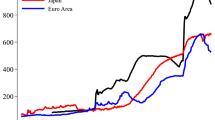Abstract
This paper investigates the informational role of prices in segmented markets which are shocked by a kind of common sentiment resulting from financial contagion. This common sentiment bridges the connection between prices learned by rational traders and thus can weaken the uncertainty from noise shock. The authors find that there exist comovement effect and crowding-out effect in information acquisition among different markets. These two effects capture financial contagion when markets experience large downward or upward tendency, which offers an explanation for market crisis to some extent.
Similar content being viewed by others
References
Barberis N, Shleifer A, and Wurgler J, Comovement, Journal of Financial Economics, 2005, 75(2): 283–317.
Yuan K, Asymmetric price movements and borrowing constraints: A rational expectations equilibrium model of crises, contagion, and confusion, The Journal of Finance, 2005, 60(1): 379–411.
Vives X, Information and Learning in Markets: The Impact of Market Microstructure, Princeton University Press, Princeton, 2010.
Grossman S J and Stiglitz J E, On the impossibility of informationally efficient markets, The American Economic Review, 1980, 70(3): 393–408.
Almazan A, Brown K C, Carlson M, et al., Why constrain your mutual fund manager?, Journal of Financial Economics, 2004, 73(2): 289–321.
Goldstein I, Li Y, and Yang L, Speculation and hedging in segmented markets, The Review of Financial Studies, 2013, 27(3): 881–922.
Duffie D, Presidential address: Asset price dynamics with slow-moving capital, The Journal of Finance, 2010, 65(4): 1237–1267.
Mendel B and Shleifer A, Chasing noise, Journal of Financial Economics, 2012, 104(2): 303–320.
Ackert L and Deaves R, Behavioral finance: Psychology, decision-making, and markets, Cengage Learning, 2009.
Cespa G and Vives X, The beauty contest and short-term trading, The Journal of Finance, 2015, 70(5): 2099–2154.
Hassan T A and Mertens T M, Market sentiment: A tragedy of the commons, The American Economic Review, 2011, 101(3): 402–405.
Vives X and Yang L, Costly interpretation of asset prices, Working paper, 2017.
Chiang C W, Investor sentiment and the cross-section of stock returns, Journal of Finance, 2007, 61(4): 1645–1680.
Ho C and Hung C H, Investor sentiment as conditioning information in asset pricing, Journal of Banking & Finance, 2009, 33(5): 892–903.
Hilliard J, Narayanasamy A, and Zhang S, The role of market sentiment in asset allocations and stock returns, Working paper, 2018.
Kodres L E and Pritsker M, A rational expectations model of financial contagion, The Journal of Finance, 2002, 57(2): 769–799.
Longstaff F A, The subprime credit crisis and contagion in financial markets, Journal of Financial Economics, 2010, 97(3): 436–450.
Chowdhry B and Nanda V, Multimarket trading and market liquidity, The Review of Financial Studies, 1991, 4(3): 483–511.
Madhavan A, Consolidation, fragmentation, and the disclosure of trading information, The Review of Financial Studies, 1995, 8(3): 579–603.
Cespa G and Foucault T, Illiquidity contagion and liquidity crashes, The Review of Financial Studies, 2014, 27(6): 1615–1660.
Da Z, Larrain B, Sialm C, et al., Price pressure from coordinated noise trading: Evidence from pension fund reallocations, Working Paper, 2015.
Author information
Authors and Affiliations
Corresponding author
Additional information
This research was supported by the National Natural Science Foundation of China under Grant No. 71771008, the Central University Fund under Grant No. PTRW1808, the Fundamental Research Funds for the Central Universities under Grant No. XK1802-5 and the Supporting Plan for Top Talents in Humanities and Social Sciences under Grant No. YWF-19-BJ-W-45.
This paper was recommended for publication by Editor WANG Shouyang.
Rights and permissions
About this article
Cite this article
Zeng, Q., Liu, S. & Zhang, Q. Common Sentiment and Price Contagion. J Syst Sci Complex 32, 1426–1437 (2019). https://doi.org/10.1007/s11424-019-7430-y
Received:
Revised:
Published:
Issue Date:
DOI: https://doi.org/10.1007/s11424-019-7430-y




